Kyosho Jutaku: Living Large in Small Spaces
The Construction Series > Earthquake >Small > Ginza > Circular > Earth > Underground
The Captain's holiday schedule is tighter than most. In addition to covering his usual Tokyo beat, the newsman has an evening Santa gig at Takashimaya department store, where his most common request is from perplexed mothers inquiring as to why his breath smells of bourbon.
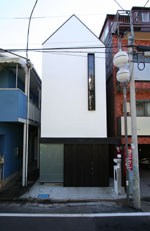 But this week he has found time to pen a piece on kyosho jutaku, a trend within the housing market where architects design funky homes on small sections of land.
But this week he has found time to pen a piece on kyosho jutaku, a trend within the housing market where architects design funky homes on small sections of land.
Fans of urban sprawl, try this: On one of Tokyo's crisper mornings, ride the elevator up to the lounge on the 41st floor of the Park Hyatt building in Shinjuku and gaze in the direction of Mt. Fuji. The view will be of a nearly uninterrupted blanket of concrete and infrastructural morass that is likely unmatched anywhere in the world for its enormity and unsightliness. Blending to fill much of this scene are massive apartment buildings and smaller, block-like "mansions," their bland concrete facades and uninspired designs resembling hospitals or penitentiaries.
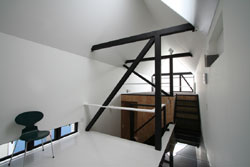 Architects like Tokyo-based Jun Ishikawa, however, are in the process of adding small bits of color to this picture - both literally and figuratively. Small slivers of land that in days past may have been used for an industrial or commercial purpose are now the location of unique housing structures. Ishikawa specializes in mokuzo (wood) structures. Wood affords him the opportunity to implement his signature style: narrow buildings with arched roofs that resemble a one-room schoolhouse or church.
Architects like Tokyo-based Jun Ishikawa, however, are in the process of adding small bits of color to this picture - both literally and figuratively. Small slivers of land that in days past may have been used for an industrial or commercial purpose are now the location of unique housing structures. Ishikawa specializes in mokuzo (wood) structures. Wood affords him the opportunity to implement his signature style: narrow buildings with arched roofs that resemble a one-room schoolhouse or church.
"Once the bubble period ended, land owners thought that the easiest way to sell some properties that were no longer suitable for a business or had other legal restrictions on them was by subdividing them into smaller sections," the architect says of one of the primary reasons for the existence of the kyosho jutaku, or micro home, which might occupy a plot whose area is only 30 square meters. "So this trend is not driven by design; it is economics. But from an architect's point of view, it is his job to satisfy the customer's needs regardless of the site conditions."
 Though still comprising a tiny fraction of Japan's housing industry, these multi-storied domiciles, emphasizing utility of space and a distinctive look, have in recent years become the trendy solution for a select few looking to get a taste of big city living.
Though still comprising a tiny fraction of Japan's housing industry, these multi-storied domiciles, emphasizing utility of space and a distinctive look, have in recent years become the trendy solution for a select few looking to get a taste of big city living.
Designs adhere to few rules, which is part of the appeal. Exteriors can include sweeping curves and undulations from top to bottom. Walls can be tipped to meet floors at angles greater than 90 degrees, mimicking the slope of a ship's hull. Roofs are not necessarily flat or even pitched at angles that result in symmetry.
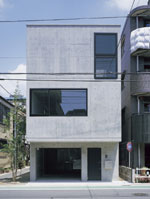 Inside, staircases spiral upward or are inclined at steep grades, whose bottom can be part of the ceiling for the room below. Railings are almost a necessity given that many designs result in each floor essentially being a wide catwalk.
Inside, staircases spiral upward or are inclined at steep grades, whose bottom can be part of the ceiling for the room below. Railings are almost a necessity given that many designs result in each floor essentially being a wide catwalk.
"These houses appeal to young people looking for something unique," explains Mie Takeuchi, a real estate advisor in Tokyo at CBX-Japan. "They have special designs that cater to individual tastes and lifestyles, and are especially popular for couples without kids."
Because of the narrow spaces, entire floors might employ one function (i.e. kitchen, bedroom, etc.) and perhaps even two. In photos, such a layout might appear quaint, but from an application standpoint, this can make life somewhat challenging.
 "It all depends on your imagination," says architect Satoshi Kurosaki of Apollo Architects & Associates. "For example, your kitchen can become your bedroom if you store the futon in a closet. For Japanese people, this sort of utilization is not unusual."
"It all depends on your imagination," says architect Satoshi Kurosaki of Apollo Architects & Associates. "For example, your kitchen can become your bedroom if you store the futon in a closet. For Japanese people, this sort of utilization is not unusual."
The type of construction materials is varied. In addition to the aforementioned wood, Kurosaki uses reinforced concrete because of its positive performance in times of earthquakes and fires and due to its soundproof qualities. It is also a very popular choice with today's buyers.
"For both interiors and exteriors, concrete allows me to freely express forms in ways that today's urban culture demands," explains the architect, who also uses light-gauge steel for structures being erected in extremely tight situations.
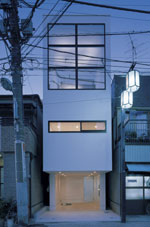 Two of the more famous examples of the kyosho jutaku aesthetic reside side-by-side in Kobe, overlooking the Akashi Kaikyo bridge. Tadao Ando, who has made an international name for himself with various adventures in concrete structures, designed the pair of three-story homes, in which one is (of course) concrete and the other wood. Each top floor, which provides a stunning view of the Akashi straight, is a separate block that has been offset by about a meter from the main structure such that two of its edges hang over the pavement below.
Two of the more famous examples of the kyosho jutaku aesthetic reside side-by-side in Kobe, overlooking the Akashi Kaikyo bridge. Tadao Ando, who has made an international name for himself with various adventures in concrete structures, designed the pair of three-story homes, in which one is (of course) concrete and the other wood. Each top floor, which provides a stunning view of the Akashi straight, is a separate block that has been offset by about a meter from the main structure such that two of its edges hang over the pavement below.
Space is not wasted. In kyosho jutaku designs, interior lights rarely rest on the floor and instead are hung from tracks or single mounts; clothing racks (closet space is rare) are found tucked into corners.
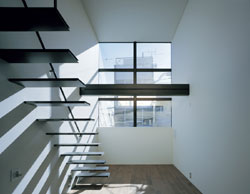 Sometimes the finished products are so narrow that they resemble books on a shelf. In the Layer House, architect Hiroaki Ohtani designed the four walls of his rectangular home, also in Kobe, to be of thin, vertically stacked strips of concrete spaced 5 centimeters apart and overlapped at the corners. The three-level, column-less structure, which only offers 33 square meters of floor space, utilizes the 5-centimeter gaps to wedge the floor boards between the 3-meter lateral space that spans from left wall to right. Interior stairs and shelving, both of which are wood planks, jut laterally from between two concrete strips.
Sometimes the finished products are so narrow that they resemble books on a shelf. In the Layer House, architect Hiroaki Ohtani designed the four walls of his rectangular home, also in Kobe, to be of thin, vertically stacked strips of concrete spaced 5 centimeters apart and overlapped at the corners. The three-level, column-less structure, which only offers 33 square meters of floor space, utilizes the 5-centimeter gaps to wedge the floor boards between the 3-meter lateral space that spans from left wall to right. Interior stairs and shelving, both of which are wood planks, jut laterally from between two concrete strips.
The tight quarters of these structures, too, make ambient light very important. In Ohtani's home, the front and back are covered by sheets of glass, which allow sunlight to pass between the gaps in the concrete and fill the space. In the designs of architect Ishikawa, he often includes multiple windows in the upper floors, which is typically where the largest open-spaced rooms (such as living rooms) are located. For Ando's creations in Kobe, two of the four walls on the third floor of both structures are composed of glass.
 Even though these homes are often only a half-meter from their neighbors, perks like parking, which for a single slot can cost a few hundred dollars a month in cities like Tokyo, are not out of the question. Some kyosho jutaku designs will use a cantilever system that will allow the first floor to be much smaller in area than upper floors, resulting in an upside down "L" shape. A space for that sedan is then possible just below the overhang and outside the front door.
Even though these homes are often only a half-meter from their neighbors, perks like parking, which for a single slot can cost a few hundred dollars a month in cities like Tokyo, are not out of the question. Some kyosho jutaku designs will use a cantilever system that will allow the first floor to be much smaller in area than upper floors, resulting in an upside down "L" shape. A space for that sedan is then possible just below the overhang and outside the front door.
Making the most of a small space is not necessarily unique to Japan's housing business. For decades, the hotel industry has lodged overnight guests in capsules, which are small cubicles shaped like a coffin. The origins for these hotels, whose rooms are oriented almost like a honeycomb, are generally traced to architect Kisho Kurokawa's stacked concrete cubes that make up the 14-floor Nakagin Capsule Tower, completed in 1972 near Tokyo's Ginza district.
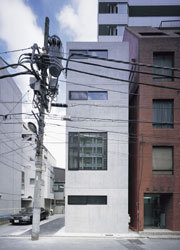 These mini homes are not without their drawbacks. Awkward angles and nearby neighbors, can make the simple washing of a window quite a task. As well, designs emphasizing concrete and glass are not conducive to energy efficiency in winter.
These mini homes are not without their drawbacks. Awkward angles and nearby neighbors, can make the simple washing of a window quite a task. As well, designs emphasizing concrete and glass are not conducive to energy efficiency in winter.
Offsetting these issues is the cost, which is fairly attractive when compared to other forms of housing, especially if land ownership is already secured.
"In comparison," says real estate advisor Takeuchi, "the prices of a kyosho jutaku will probably be between that of a new mansion and a new ready-made house. However, if you already own the land, this method will definitely be cheaper than buying a new mansion."
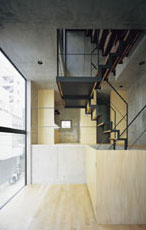 Down the line, however, the drawbacks - and the fact that the original design was likely highly personal to the initial owner - make resale of these properties somewhat difficult, Takeuchi adds, saying that the rental market might be the way to go.
Down the line, however, the drawbacks - and the fact that the original design was likely highly personal to the initial owner - make resale of these properties somewhat difficult, Takeuchi adds, saying that the rental market might be the way to go.
Since architect Kurosaki sees the kyosho jutaku as a part of an evolution in Japanese construction, which was characterized in the Edo Period (1603-1868) by the minka, or wood farmhouse, he believes that these micro homes will continue to expand in scope, much like the progress that in the past gave birth to small offices and small shops.
"Because of the demand in Tokyo for multi-use, 4- to 5-floor complexes, like those found in New York and Paris," he says, "uniting the kyosho jutaku concept into these types of structures will be the next step. But the important element will be to first formulate an idea that can become a reality."
Note: A similar version of this article will appear in "Small House Tokyo," a book soon to be published by Cocoro Books. All photos used by permission of Jun Ishikawa and Satoshi Kurosaki.
The Construction Series > Earthquake >Small > Ginza > Circular > Earth > Underground

